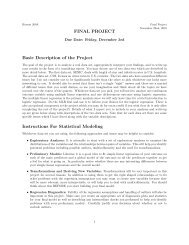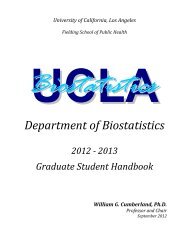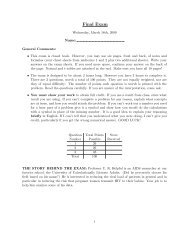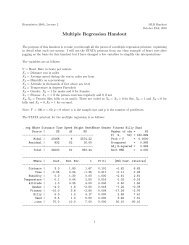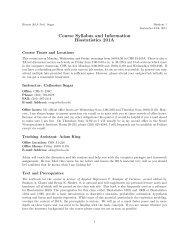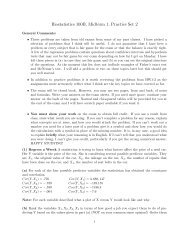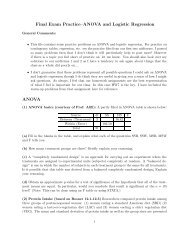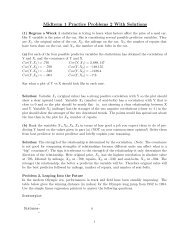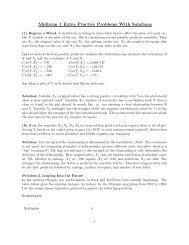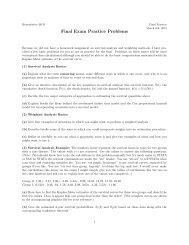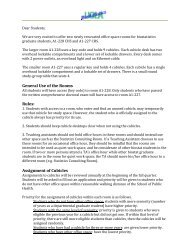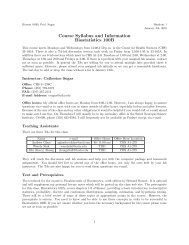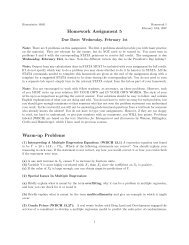Solutions to This Year's Final Exam
Solutions to This Year's Final Exam
Solutions to This Year's Final Exam
Create successful ePaper yourself
Turn your PDF publications into a flip-book with our unique Google optimized e-Paper software.
2011 <strong>Final</strong> <strong>Exam</strong> With <strong>Solutions</strong>THE STORY BEHIND THE EXAM: Dr. Caroline R. Ash, a community health scientist andpublic health policy expert at our favorite school, the University of Calculationally Literate Adults,studies traffic accidents. She is interested in what fac<strong>to</strong>rs “drive” both non-fatal and fatal accidentsand also in the effectiveness of different programs for preventing them. During the exam you willhelp her analyze data she has collected from several neighboring cities (Los Seraphim, Hollybrickand Beverly Flats) and interpret the results. In particular, Mayor N. D. Burns of Los Seraphimhas asked her <strong>to</strong> comment on the effectiveness of the holiday driving safety program in his city.Note: Unless otherwise indicated use α = .05 for all hypothesis tests on this exam.1
Question 1: ’Tis The Season (34 points, 50 minutes)The winter holiday season is, unfortunately, a peak time for bad traffic accidents. Twenty yearsago the city of Los Seraphim instituted an agressive program <strong>to</strong> promote safe driving practicesduring this period. The campaign includes advertisements, stepped up traffic patrols, drunkdrivingcheckpoints and extra penalties for traffic violations. The city has been collecting data onY , the number of serious traffic accidents during the holidays, each year since the program began.Let X 1 represent Time since the start of the program, so that the intial year was X 1 = 0 and thecurrent year is X 1 = 20 and let X 2 be the Population of Los Seraphim in each of the same years.Mayor Burns has asked Dr. Ash <strong>to</strong> look at whether the program has been effective in reducingserious accidents over this period. Dr. Ash has had her graduate student run some preliminaryanalyses. The results are shown below.. regress NumAccidents TimeSource | SS df MS Number of obs = 21-------------+------------------------------ F( 1, 19) = 15.90Model | 9443.48679 1 9443.48679 Prob > F = 0.0008Residual | 11285.0679 19 593.950941 R-squared = 0.4556-------------+------------------------------ Adj R-squared = 0.4269Total | 20728.5547 20 1036.42773 Root MSE = 24.371------------------------------------------------------------------------------NumAccidents | Coef. Std. Err. t P>|t| [95% Conf. Interval]-------------+----------------------------------------------------------------Time | 3.502038 .8782738 3.99 0.001 1.66379 5.340286_cons | 137.3211 10.26742 13.37 0.000 115.8312 158.8111------------------------------------------------------------------------------******************************************************************************. regress NumAccidents Time PopulationSource | SS df MS Number of obs = 21-------------+------------------------------ F( 2, 18) = 40.48Model | 16957.9351 2 8478.96754 Prob > F = 0.0000Residual | 3770.61959 18 209.478866 R-squared = 0.8181-------------+------------------------------ Adj R-squared = 0.7979Total | 20728.5547 20 1036.42773 Root MSE = 14.473------------------------------------------------------------------------------NumAccidents | Coef. Std. Err. t P>|t| [95% Conf. Interval]-------------+----------------------------------------------------------------Time | -1.924553 1.045449 -1.84 0.082 -4.12096 .2718537Population | .0000983 .0000164 5.99 0.000 .0000638 .0001328_cons | 43.24295 16.84962 2.57 0.019 7.843222 78.64268------------------------------------------------------------------------------2
Part a (5 points)Based on these two models do you see evidence of confounding and multicollinearity? Explain brieflyand say what the implications are for the interpretation of and conclusions about the regressioncoefficients in the second model. You may find the summary statistics below useful in justifyingyour answers.. estat vif . cor Time Population (obs=21)Variable | VIF 1/VIF | Time Popula~n-------------+---------------------- -------------+------------------Population | 4.02 0.248911 Time | 1.0000Time | 4.02 0.248911 Population | 0.8667 1.0000-------------+----------------------Mean VIF | 4.02Solution: There is definitely evidence of multicollinearity and confounding in these prin<strong>to</strong>uts. Multicollinearityoccurs if there is a relationship between two or our of the predic<strong>to</strong>r variables. Here wesee that there is a very strong correlation, r = .8667, between the predic<strong>to</strong>rs Time and Population.Moreover, the variance inflation fac<strong>to</strong>rs (VIFs) for Time and Population in the second model areabove 4 which is our standard cu<strong>to</strong>ff for indicating that multicollinearity has had a significant impac<strong>to</strong>n the model parameters. Confounding occurs when there is a substantial difference in yourinterpretation of the relationship between a predic<strong>to</strong>r X and an outcome Y depending on whetheror not a third variable Z (the potential confounder) is included in the model. Here Population isa confounder for the relationship between Time and Number of Accidents. In the SLR there is asignificant positive relationship between Time and Accidents. However, after adding Population <strong>to</strong>the model the relationship between Time and Number of Accidents has become negative and infact is not statistically sigificant if we use a two-sided significance level of α = .05. The fact thatwe have confounding and substantial multicollinearity in this model means that that estimates ofthe regression coefficients in the second model are not very stable. As indicated by the VIFs theirstandard errors are inflated meaning there is a great deal of uncertainty about their magnitude andpossibly about their significance/sign as well. Thus we need <strong>to</strong> be cautious about making precisestatements about those effect. Note that we are probably much more confident about the sign andsignificance of the population effect since it’s p-value is miniscule but even there we do not havegreat precision about the magnitude of the effect.Part b (4 points)Mayor Burns doesn’t like the first prin<strong>to</strong>ut because he thinks the positive relationship betweenTime and Number of Accidents implies his safety program hasn’t worked. He likes the secondprin<strong>to</strong>ut much better and says that the negative sign on the Time variable in this model supportshis theory that the program has reduced the number of accidents. Is there merit <strong>to</strong> either of themayor’s interpretations? Discuss briefly.3
Solution: Mayor Burns obviously didn’t major in statistics. There is no merit <strong>to</strong> his first statementand his second one is also questionable although it is at least not flatly inconsistent with thedata. With regard <strong>to</strong> the first statement, just because the number of accidents went up over timedoesn’t mean the safety program didn’t work. The best measure of how well the safety programworked is probably the accident rate, not the number of accidents and it is entirely possible forthe number of accidents <strong>to</strong> go up even while the rate stays constant or even goes down. Indeedif the population increased over time but the rate stayed constant then the number of accidentswould rise. As we saw in the second model once we account for population there is no longer apositive relationship between time and accident, which suggests that the reason for the increase innumber of accidents was at least partly population growth. (To confirm this it would be helpful<strong>to</strong> have seen the correlation between Time and Population.) Secondly, even if population growthhadn’t accounted for the increase in number of accidents that wouldn’t mean the program was atfault. It could be that the number of accidents would have gone up even faster if the programhadn’t been in place. The Mayor’s second statement is slightly better. The multiple regressionindicates that after adjusting for Population our best estimate is that the number of accidents hasgone down over time which would be consistent with the program working. We could even claimthat this result is significant if we did a one-sided test (which could be justified if we were trying<strong>to</strong> prove the theory that the program worked) although this is pretty borderline and the instabilitycaused by the multicollinearity/confounding lowers our confidence about the results. However evenif we could say with certainty that the accident rate had declined over time that wouldn’t be proofthat the safety program was the reason even though the two things coincided. Correlation is notcausation!Based on parts (a) and (b) the graduate student decides <strong>to</strong> create a new outcome variable, Per-CapAccidents, which is the number of accidents during the holidays per ten thousand people. Thesimple linear regression of the new “per capita” accident rate on time is shown below along withcorresponding diagnostic plots. Use this output <strong>to</strong> answer parts (c)-(e).. regress PerCapAccidents TimeSource | SS df MS Number of obs = 21-------------+------------------------------ F( 1, 19) = 19.09Model | .424191401 1 .424191401 Prob > F = 0.0003Residual | .422297866 19 .022226203 R-squared = 0.5011-------------+------------------------------ Adj R-squared = 0.4749Total | .846489267 20 .042324463 Root MSE = .14908------------------------------------------------------------------------------PerCapAcci~s | Coef. Std. Err. t P>|t| [95% Conf. Interval]-------------+----------------------------------------------------------------Time | -.0234712 .0053726 -4.37 0.000 -.0347163 -.0122262_cons | 1.411111 .0628085 22.47 0.000 1.279651 1.542571------------------------------------------------------------------------------4
Part c (6 points)Use the plots from the previous page <strong>to</strong> discuss whether each of our main regression assumptionsis violated. You should make it clear which plot(s) you are using <strong>to</strong> assess each assumption.Solution: We assume that the errors are mean 0, independent, constant variance and normallydistributed. The first three assumptions are checked with the residual or scatterplot and the normalityassumption is checked with the his<strong>to</strong>gram or qq plot. For mean 0 we need the errors <strong>to</strong>be centered around the 0 line in the residual plot for all values of X. In this case the errorsare mostly positive for small X, them mostly negative for medium values of X and then positivefor large values of X so this assumption is violated. (Note that it is not enough for the positiveand negative errors <strong>to</strong> be balanced overall–they have <strong>to</strong> be balanced at each X.) The pattern weobserved looking at the mean 0 assumption also tells us the independence asusmption is violated.There is a systematic curved shape <strong>to</strong> the erros that suggests we have fit the wrong model–a curvedrelationship between accident rate and time would probably fit these data better. Note that themean 0 and independence assumptions usually go <strong>to</strong>gether. For the constant variance assumptionwe need the spread of the band of the residuals <strong>to</strong> be the same width for all X. Note that thisdoesn’t mean that the spread has <strong>to</strong> go equally high above and below the 0 line. If the mean 0and independence asusmptions are violated the band will be curved but it can still be the same“fatness” all the way along. Here we don’t have many points at each value of X so it is hard <strong>to</strong>judge the width of the band well. Some people said it was wider in the middle and narrower atthe ends while others said it was OK. We accepted either answer as long as it was clear you knewwhat you were looking for.Part d (5 points)Do you see any possible outliers or influential points? Explain (i) based on the scatter plot and (ii)based on the diagnostic statistics below. Do you think any of the points are problematic enoughthat they need <strong>to</strong> be removed? Discuss briefly.Time StudentizedRes Leverage CooksDistance DFBeta(Time)0 6.29 .18 1.41 -2.4911 -1.17 .05 .03 -0.0421 1.02 .18 .11 0.41Next Highest -1.08 .15 .07 0.31Solution: First, looking at the scatterplot, we see that the Time=0 point looks quite separatedfrom the others. <strong>This</strong> point looks like an outlier in Y . <strong>This</strong> point is also the worst based onthe diagnostics shown above. It’s studentized residual is a whopping 6.29, well above our usualthreshold of 2 or 3. None of the other points comes close <strong>to</strong> being a problem in this respect. It isalso tied for the highest leverage value at .18. Our threshold for being high leverage is 2(p + 1)/nwhere p is the number of predic<strong>to</strong>rs and n is the sample size. Here p = 1 and n = 21 so the cu<strong>to</strong>ffwould be 2(1 + 1)/21 = .19 which our point doesn’t meet although it is close. None of these pointshas super high leverage although naturally the points at the edge of the data set (Time = 0 andTime = 20) are the highest. The Time=0 point also has by far the largest Cook’s Distance andDFBeta values suggesting it is the most influential. Our rough rules of thumb said that points with5
Cook’s Distances above 1 or DFBetas above 2 are influential. Thus according <strong>to</strong> the diagnostics ourpoint is an influential outlier and may well be affecting the fit of the line. However you can’t justsay on this basis that the point should be removed. To justify that we’d need some reason for sayingthe point was a mistake or not representative of the population of interest. If that isn’t the casethen you’d need <strong>to</strong> fit the model with and without the point and report exactly how big an effectit is having on your conclusions (e.g. significance and direction of the relationship.) However herewe have a different problem: The point is probably looking like an outlier because we have fit thewrong model. The error diagnostics suggested that a curvilinear model would fit the data better.If we sketch in a curved shape for the relationship suddenly the point at Time=0 is right in linewith the others. There is one semi-reasonable argument you could make for removing this point.Since it represents the first year the program was implemented you could speculate that the safetyrules had not had time <strong>to</strong> fully take effect or that there were still some bugs in implementation andthus the period starting with Time=1 would better reflect the effects of the program. However it isgenerally a good idea <strong>to</strong> look at change from the baseline <strong>to</strong> understand the progression over time.Part e (4 points)Mayor Burns like this model <strong>to</strong>o. He decides <strong>to</strong> predict what the per capita accident rate will belike 50 years from now. Does the answer he gets make real-world sense? If so why? If not whathas gone wrong?Solution: We note that the program started 20 years ago so 50 years from now will correspond <strong>to</strong>Time= 70. Plugging in this value our predicted accident rate isŶ = b 0 + b 1 T ime = 1.41 − .0235(70) = −.235or negative .235 accidents per 10,000 people or about negative 2 accidents per 100,000 peopple.Obviously this doesn’t make any sense–you can’t have negative accidents! What has gone wrongof course is that we have extrapolated WAY outside the range of our data. It is highly unlikelythat the model that works for accident rate now will still be correct in 50 years when the city mayhave changed completely. Moreover we know from parts (c) and (d) that the model we have fitis not even the right one for the current data so if we extrapolate this far we guaranteed <strong>to</strong> be introuble. Mayor Burns is offering even more evidence that he knows nothing about statistics! Notethat some people plugged in Time=50 rather than Time=70. If you do that you get a predictedaccident rate of around .235. While this number is physically possible it doesn’t fit at all with thescatterplot which shows the accident rate leveling off at about 1 per 10,000 people so you can stilltell that the extrapolation is unreasonable.6
Next the graduate student decides <strong>to</strong> try out some transformations of the time variable. Specificallyshe tries (i) adding a quadratic term, TimeSq, (ii) using LogTime and (iii) fitting an inverse modelin which the predic<strong>to</strong>r is InvTime=1/(1+Time). The corresponding prin<strong>to</strong>uts are shown below.. regress PerCapAccidents Time TimesqSource | SS df MS Number of obs = 21-------------+------------------------------ F( 2, 18) = 28.05Model | .640837754 2 .320418877 Prob > F = 0.0000Residual | .205651513 18 .011425084 R-squared = 0.7571-------------+------------------------------ Adj R-squared = 0.7301Total | .846489267 20 .042324463 Root MSE = .10689------------------------------------------------------------------------------PerCapAcci~s | Coef. Std. Err. t P>|t| [95% Conf. Interval]-------------+----------------------------------------------------------------Time | -.0856247 .0147838 -5.79 0.000 -.1166842 -.0545651Timesq | .0031077 .0007137 4.35 0.000 .0016083 .004607_cons | 1.60793 .0638021 25.20 0.000 1.473887 1.741974------------------------------------------------------------------------------******************************************************************************. regress PerCapAccidents LogTimeSource | SS df MS Number of obs = 21-------------+------------------------------ F( 1, 19) = 73.14Model | .67194482 1 .67194482 Prob > F = 0.0000Residual | .174544447 19 .00918655 R-squared = 0.7938-------------+------------------------------ Adj R-squared = 0.7829Total | .846489267 20 .042324463 Root MSE = .09585------------------------------------------------------------------------------PerCapAcci~s | Coef. Std. Err. t P>|t| [95% Conf. Interval]-------------+----------------------------------------------------------------LogTime | -.5162129 .0603585 -8.55 0.000 -.6425447 -.3898812_cons | 1.660861 .060384 27.51 0.000 1.534476 1.787246------------------------------------------------------------------------------*****************************************************************************. regress PerCapAccidents InvTimeSource | SS df MS Number of obs = 21-------------+------------------------------ F( 1, 19) = 212.33Model | .776962532 1 .776962532 Prob > F = 0.0000Residual | .069526735 19 .003659302 R-squared = 0.9179-------------+------------------------------ Adj R-squared = 0.9135Total | .846489267 20 .042324463 Root MSE = .06049------------------------------------------------------------------------------PerCapAcci~s | Coef. Std. Err. t P>|t| [95% Conf. Interval]-------------+----------------------------------------------------------------InvTime | .8970007 .061559 14.57 0.000 .7681561 1.025845_cons | 1.02069 .0169836 60.10 0.000 .9851429 1.056237------------------------------------------------------------------------------7
Part f (4 points)Give a brief interpretation of the coefficient of the LogTime variable and in particular explain whatthe negative sign tells you in real-world terms. How does this fit with the mayor’s theory?Solution: The literal interpretation of the value b 1 = −.516 is that for every one unit increase inLogTime the accident rate drops by about half an accident per 10,000 people. We need <strong>to</strong> be a bitmore precise though. First, what does a one unit change in LogTime mean? LogTime goes up by 1when Time on the original scale is doubled <strong>This</strong> is assuming that we are using Log Base 2 whichI didn’t actually say. (Thus we get a drop of .5 in the accident rate going from time 1-2, 2-4, 4-8,8-16, etc.) If it were log base 10 or natural log it would correspond <strong>to</strong> time being multipled by afac<strong>to</strong>r of 10 or 2.73 respectively. The time it takes for each successive drop of .5 per 10,000 peoplein the accident rate gets longer and longer. What this means is that the accident rate is decliningover time but at an ever slower rate–the log function decreases less rapidly than a straight line.However the log function does NOT level off–our regression equation will get arbitrarily large andnegative if we extrapolate far enough. Since the accident rate is decreasing over time this model isconsistent with the theory that the program is working although as we have noted before we cannot prove the program is causing the decrease–correlation is not causation.Part g (6 points)Rank the three transformations from best <strong>to</strong> worst. Briefly explain how you are making your choiceand say whether the best model makes real-world sense.Solution: We can rank the models based on Radj2 (for which higher values are better) or theRMSE (for which lower values are better). Using these criteria the InverseTime model is the best,followed by the LogTime model and the worst is the TimeSquared model (though even it is fairlygood.) Note that it is not a good idea <strong>to</strong> use raw R 2 which always gets bigger as you add morevariables, nor can we directly compare the F values and their p-values since the models do not allhave the same number of variables and what counts as a significant F test value depends on thedegrees of freedom. Some people said we couldn’t compare RMSE’s because the transformationsmeant the models weren’t on the same scale. <strong>This</strong> would be correct if we’d transformed Y but ourtransformations were all on the predic<strong>to</strong>r, X, which doesn’t effect the scale. RMSE is un units ofY and here the Y variable was always the same.The inverse model Ŷ = 1.02 + .897/(1 + T ime) does make a good deal of practical sense here. AsTime goes by, 1/(1 + T ime) gets smaller and smaller so the equation levels off <strong>to</strong> a value of 1.02.Since the sign on the inverse term is positive the function is actually decreasing in Time. (To seethis note that at Time = 0 our predicted value is 1.917 and that the amount we add <strong>to</strong> the b 0value of 1.02 gets smaller with each step.) <strong>This</strong> suggests that initially the program has a fairlylarge impact on the accident rate but that there are diminishing returns over time until eventuallyeveryone has learned or adjusted <strong>to</strong> the program conditions and there is no further change. Ofcourse there will still be some accidents because there are still effects of weather, bad roads, badluck and people who simply ignore the program which is why the limiting accident rate isn’t 0.8
Question 2: Intercity Interactions (29 points, 40 minutes)Dr. Ash points out <strong>to</strong> her graduate student that there would be more convincing evidence forthe effectiveness of the Los Seraphim traffic safety program if the time trend found at the end ofQuestion 1 could be compared with those in some other similar cities. Data are available from theneighboring communities of Hollybrick (which has no accident prevention program) and BeverlyFlats (which has been running ads promoting safe driving during the holidays but has no otherspecial programs). The graduate student creates indica<strong>to</strong>r variables for each city. LS = 1 if thecity is Los Seraphim and 0 otherwise, HB=1 if the city is Hollybrick and 0 otherwise and BF=1 ifthe city is Beverly Flats and 0 otherwise. The prin<strong>to</strong>ut for a regression of per capita accident rateon the indica<strong>to</strong>rs HB and BF is shown below.. regress PerCapAccidents HB BFSource | SS df MS Number of obs = 63-------------+------------------------------ F( 2, 60) = 14.26Model | 1.98425675 2 .992128374 Prob > F = 0.0000Residual | 4.17565874 60 .069594312 R-squared = 0.3221-------------+------------------------------ Adj R-squared = 0.2995Total | 6.15991548 62 .099353476 Root MSE = .26381------------------------------------------------------------------------------PerCapAcci~s | Coef. Std. Err. t P>|t| [95% Conf. Interval]-------------+----------------------------------------------------------------HB | .3874778 .0814127 4.76 0.000 .2246282 .5503275BF | .3644091 .0814127 4.48 0.000 .2015595 .5272588_cons | 1.176399 .0575675 20.44 0.000 1.061247 1.291551------------------------------------------------------------------------------Part a (5 points)Based on this model does there seem <strong>to</strong> be overall evidence of a significant difference in accidentrates among the three cities? State the matehmatical hypotheses you would be testing using (i) theregression framework and (ii) the classical ANOVA framework and your real-world conclusions.Solution: To see whether there is overall evidence of a difference in accident rates we need <strong>to</strong> doan F test. In the regression framework our hypotheses are:H 0 : β HB = β BF = 0–the mean accident rates for HollyBrick and Beverly Flats are no differentfrom that for Los Seraphim.H A : At least one of β HB , β BF ≠ 0–there are some differences among the cities.In the classical ANOVA framework we compare the means of each group directly rather than lookingat differences from a reference group. Here we would haveH 0 : µ LS = µ HB = µ BF –the cities all have the same average accident rate.H A : the means are not all equal; the accident rates differ across cities.9
Note that in the first set of hypotheses I am testing whether the parameters are equal <strong>to</strong> 0–I amchecking for a non-zero difference between the groups. In the second set of hypotheses I do NOTneed the “=0” piece because I am looking at the actual accident rates and the goal is <strong>to</strong> see whetherthey are the same, not whether they are equal <strong>to</strong> 0-.From the regression prin<strong>to</strong>ut the F statistic for the test is F obs = 14.26 and the correspondingp-value is essentially 0 so we reject the null hypothesis and conclude that there is evidence of adifference in accident rates across the cities.Part b (5 points)Use the prin<strong>to</strong>ut <strong>to</strong> find the estimated mean accident rate for each of the three cities and from tha<strong>to</strong>btain the regression equation you would have gotten if Hollybrick had been used as the referencecity.Solution: In the regression ANOVA framework, the intercept gives the mean value of Y for thereference group. Here Los Seraphim is the reference group so we see that the average accident ratethere is 1.176 accidents per 10,000 people. To get the means for the other cities we have <strong>to</strong> plug intheir respective indica<strong>to</strong>rs:HollyBrick: Ŷ = 1.176 + .387(1) + .364(0) = 1.563Beverly Flats: Ŷ = 1.176 + .387(0) + .364(1) = 1.54Now <strong>to</strong> get the equation with HollyBrick as the reference city we simply use it’s mean as the interceptand for the coefficients of the other two indica<strong>to</strong>rs we use their difference from the reference group.We note that LS - HB = 1.176 - 1.563 = -.387 (this is just the negative of what we got as thecoefficient of HollyBrick when Los Seraphim was the reference.) Similarly for Beverly Flats we getBF-HB = 1.54 - 1.563 = -.023. The resulting regression equation isPart c (6 points)Ŷ = 1.563 − .387LS − .23BFFind the effect sizes associated with the differences in accident rates between the three cities andsay whether they are large by the standards we learned in class. Do you think this study turnedout <strong>to</strong> have been adequately powered? Would you have said it was adequately powered before itstarted? Explain briefly. The following prin<strong>to</strong>ut may be helpful.. sampsi 0 .89, sd1(1) sd2(1) n1(20) n2(20) alpha(.05)Estimated power for two-sample comparison of meansTest Ho: m1 = m2, where m1 is the mean in population 1and m2 is the mean in population 2Assumptions:10
alpha = 0.0500 (two-sided)m1 = 0m2 = .89sd1 = 1sd2 = 1sample size n1 = 20n2 = 20n2/n1 = 1.00Estimated power:power = 0.8036Solution: The effect sizes here are just the difference in means between the cities divided by thewithin group standard deviation. SInce this is an ANOVA we are assuming all the groups have thesame standard deviation and it is estimated by RMSE = .264 from the regression prin<strong>to</strong>ut. Oureffect sizes are therefore:LS vs HB: d = (1.563 − 1.176)/.264 = 1.47LS vs BF: d = (1.54 − 1.176)/.264 = 1.38HB vs BF: d = (1.563 − 1.54)/.264 = .087The first two effects, comparing Los Serpahim <strong>to</strong> each of the ohter cities, are very large (in fac<strong>to</strong>ur rough rule of thumb says anything over about .8 of a standard deviation is a large effect) whilethe difference between HollyBrick and Beverly Flats is very small. After the fact it seems thatthe study was well powered. The first two observed effects were very large and the tests came outsignificant. Any time you get a significant result it means you were able <strong>to</strong> detect the result youwere looking for. We didn’t get a significant result for HB vs BF but it looks like there really justisn’t a difference there. However before the study it would not have looked like the study waswell powered. From the STATA prin<strong>to</strong>ut our minimum detectable effect with 80% power is d = .89which is a large effect. <strong>This</strong> means that our study was only likely <strong>to</strong> see effects if they were ratherlarge. Unless we had some argument for why we would expect the effects <strong>to</strong> be large this wouldnot be considered adequate power.Part d (Optional Bonus:)Given your findings in Question 1, an ANOVA is probably not an appropriate model for these data.Give two reasons, one having <strong>to</strong> do whether whether the model will fit well and one having <strong>to</strong> dowith whether the data fulfill the model assumptions.Solution: From Question 1 we know that there is a significant time trend in the accident rates,at least in Los Seraphim. Since we are leaving out a highly significant predic<strong>to</strong>r it seems unlikelyour model will describe the accident rates particularly well. Moreover, the fact that there is atime trend means that if we ignore it our regression assumptions will be violated. In particularthe residuals (which here are differences from the city mean) will not be independent (they will becorrelated over time) and they will also not be normally distributed. The latter can be seen bynoting that for Los Seraphim at least the accident rate started out high and then leveled off so that11
for the last 10 years most of the Y values were very similar whle the ones for the first few yearswere much higher. <strong>This</strong> will lead <strong>to</strong> a skewed distribution.After listening <strong>to</strong> Dr. Ash explain the answer <strong>to</strong> part (d), the graduate student fits a new modelwith the two city indica<strong>to</strong>rs, inverse time and the interactions between city and inverse time. Thenew prin<strong>to</strong>ut is shown below. Use it <strong>to</strong> answer the remaining questions.. regress PerCapAccidents HB BF InvTime InvTimeHB InvTimeBFSource | SS df MS Number of obs = 63-------------+------------------------------ F( 5, 57) = 57.25Model | 5.13697321 5 1.02739464 Prob > F = 0.0000Residual | 1.02294228 57 .017946356 R-squared = 0.8339-------------+------------------------------ Adj R-squared = 0.8194Total | 6.15991548 62 .099353476 Root MSE = .13396------------------------------------------------------------------------------PerCapAcci~s | Coef. Std. Err. t P>|t| [95% Conf. Interval]-------------+----------------------------------------------------------------HB | .5416091 .0531904 10.18 0.000 .4350972 .648121BF | .2478435 .0531904 4.66 0.000 .1413316 .3543554InvTime | .8970007 .1363267 6.58 0.000 .6240112 1.16999InvTimeHB | -.8879118 .192795 -4.61 0.000 -1.273977 -.5018464InvTimeBF | .6715053 .192795 3.48 0.001 .2854398 1.057571_cons | 1.02069 .0376113 27.14 0.000 .9453747 1.096005------------------------------------------------------------------------------Part e (7 points)Did adding the time and interaction terms improve the model relative <strong>to</strong> the one with just thecity indica<strong>to</strong>rs? Write down the null and alternative hypotheses corresponding <strong>to</strong> this test bothmathematically and in words, obtain the test statistic and say whether or not you think the testwill be significant (you can’t get the exact p-value but you should be able <strong>to</strong> make an educatedguess!) Explain briefly how you could get STATA or SAS <strong>to</strong> perform this test for you.Solution: Here we are being asked <strong>to</strong> compare the model from part (a) <strong>to</strong> the new model using apartial F test. Our hypotheses areH 0 : β 3 = β 4 = β 5 = 0–none of the time or interaction terms improves the model.H A : At least one of the β ′ s ≠ 0–the second model is an improvement over the first.Our test statistic isF =(SSR full − SSR red )/m (5.14 − 1.98)/3= = 58.86SSE full /(n − p − m − 1) 1.02/5712
Note that m = 3 is the difference in the number of variables between the two models, n = 63 is thesample size and p = 2 is the number of predic<strong>to</strong>rs in the original model. To get the exact p-value wewould need STATA or SAS. However experience tells us that F values even around 5 or 6 are oftensignificant (depending on the exact degrees of freedom) and a value like 58.86 is huge. Moreoverall of the time and interaction terms are individually highly significant in the second model. All ofthese things <strong>to</strong>gether suggest that we will be rejecting our null hypothesis. The second model isdefinitely a better fit for the data than the first.There are several ways we could get STATA or SAS <strong>to</strong> perform this test for us. One would be <strong>to</strong>use a follow-up test or contrast statement of the form “test InvTime = InvTimeBF = InvTimeHB= 0”. Another would be <strong>to</strong> treat city as a multilevel categorical variable so that the output wouldau<strong>to</strong>matically give the p-values for whether city and it’s interaction with time were significant.Note though that this latter approach isn’t really quite good enough since we are adding not justthe interaction but also the time variable. If you got confused from the wording of the problemabout whether you were just testing for the interaction or for all three variables we were prettymerciful on the scoring.Part f (6 points)Give an intuitive explanation of what an interaction means in the context of this model. Thendescribe as carefully you can the differences in the trends of the accident rates over time for thethree cities. What does this suggest about whether the safety programs have been helping <strong>to</strong> reduceaccident rates? (Note: As always with interactions you may find it helpful <strong>to</strong> plug in the values ofthe indica<strong>to</strong>rs and get the resulting equations for each city.)Solution: The general definition of an interaction between two predic<strong>to</strong>rs X 1 and X 2 is that therelationship between Y and X 1 depends on the value of X 2 and vice versa. Here that means thatthe relationship between accident rate and time depends on which city you are in (i.e. the citieshave different time trends for accident rate) or equivalently that the differences between the citieschange over time. If we plug in the indica<strong>to</strong>rs for the cities we get the following:LS: Ŷ = 1.02 + .897InvT imeHB: Ŷ = 1.02 + .542 + .897InvT ime − .888InvT ime = 1.562 − .009InvT imeBF: Ŷ = 1.02 + .248 + .897InvT ime + .672InvT ime = 1.268 + 1.569InvT imeWhat we see is that in Hollybrick the accident rate is almost flat at 1.562 accidents per 10,000people. In both Los Seraphim and Beverly Flats the accident rate is decreasing over time (whichmakes sense since they both instituded safety programs at the start of the period covered by thedata). However the accidents are decreasing at different speeds and have different limiting rates. Inparticular we eventually expect Hollybrick <strong>to</strong> have the highest accident rate, around 1.562, followedby Beverly Flats at 1.268 and Los Serpahim will have the loest rate around 1.02 accidents per 10,000people. <strong>This</strong> all makes perfect sense since Hollybrick has no safety program (so we wouldn’t expectits accident rate would change), Berverly Flats has a modest one and Los Seraphim has the mostagressive program. Our evidence that the programs work is certainly stronger now in that wehave data from three otherwise probably quite comparable cities whose accident rates correspond<strong>to</strong> what we would expect given their respective safety programs. However since this is not a13
controlled experiment and we have not explicitly accounted for other fac<strong>to</strong>rs which might differbetween the cities and be related <strong>to</strong> the outcome we certainly don’t have definitive proof that it isthe programs that have caused the differences we see.Part g (Optional Bonus)Note that the R 2 value for this model is much lower than that in the final model of Question 1. Isthis surprising? Explain briefly.Solution: <strong>This</strong> isn’t very surprising at all as the models are for two different data sets. The firstmodel covers only Los Seraphim while the second model adds two additional cities. It is entirelypossible that there is more variability in accident rates in HollyBrick and Beverly Flats or that theinverse time model we selected based on Los Seraphim doesn’t fit the other cities so well. Eitherof these things would lead <strong>to</strong> the overall R 2 value for the second model being lower.14
Question 3: Don’t Drink and Derive (37 points, 50 minutes)Next, rather than looking at trends over time, Dr. Ash decides <strong>to</strong> focus on the fac<strong>to</strong>rs associatedwith traffic fatalities using data from the last 300 serious traffic accidents in Los Seraphim. She hasrecorded whether or not the accidents involved fatalities (Y = 1 for yes and Y = 0 for no) as wellas the predic<strong>to</strong>rs listed below. Note that all personal characteristics (e.g. gender, drinking status)refer <strong>to</strong> the at fault driver or vehicle.X 1 : Holiday season. X 1 = 1 if the accident <strong>to</strong>ok place during the holidays and 0 if not.X 2 : Drinking status. X 2 = 1 if the driver was legally in<strong>to</strong>xicated and 0 if not.X 3 : Gender. X 3 = 1 for female and 0 for male.X 4 : Age, in years.X 5 : Age squared.X 6 : Speed, in miles per hour.X 7 : Dark. X 7 = 1 if the accident <strong>to</strong>ok place after sunset and 0 otherwise.X 8 : Speed by Dark interaction. X 8 = X 6 ∗ X 7 .X 9 , X 10 : Indica<strong>to</strong>rs for the number of cars involved in the accident. <strong>This</strong> is divided in<strong>to</strong> threecategories: solo (1 car), pair (2 cars) or multi (3 or more cars). X 9 = 1 if it was a “solo” accidentand 0 otherwise and X 10 = 1 if it was a “multi-car” (3 or more vehicles) accident.Dr. Ash suspects that accidents are more likely <strong>to</strong> be fatal during the holidays than at other times.To test her theory she performs a simple logistic regression with X 1 as her predic<strong>to</strong>r.. logistic fatal holidayLogistic regression Number of obs = 300LR chi2(1) = 3.92Prob > chi2 = 0.0478Log likelihood = -161.02363 Pseudo R2 = 0.0120------------------------------------------------------------------------------fatal | Odds Ratio Std. Err. z P>|z| [95% Conf. Interval]-------------+----------------------------------------------------------------holiday | 1.77907 .5120566 2.00 0.045 1.012041 3.127433------------------------------------------------------------------------------Part a (4 points)Write down the mathematical hypotheses for the test Dr. Ash would use <strong>to</strong> try <strong>to</strong> prove her theoryand give the corresponding p-value and your real-world conclusions.Solution: Dr. Ash is trying <strong>to</strong> prove the likelihood of a fatal accident is higher during the holidayswhich is a 1-sided test. Her hypotheses are thereforeH 0 : β 1 ≤ 0–The likelihood of a car accident being fatal during the hiliday season is the same orlower as during the non-holiday period.H 0 : β 1 > 0–The likelihood of an accident being fatal is higher during the holidays.15
To get the 1-sided p-value we have <strong>to</strong> divide STATA’s p-value by 2 so we get .0225. Since thisis less than our significancel level of α = .05 we reject the null hypothesis and conclude that thelikelihood of an accident being fatal is higher during the holidays.Part b (Optional Bonus)The table below shows the actual numbers of accidents (fatal and non-fatal) for each of the timeperiods considered (holiday or not). Show how you could calculate the odds ratio comparing holiday<strong>to</strong> non-holiday periods based on the table and verify that your answer is consistent with thelogistic regression prin<strong>to</strong>ut.FatalHoliday Yes No TotalYes 27 60 87No 43 170 213Total 70 230 300Solution: The odds ratio we want simply compares the odds of an accident being fatal duringthe holidays <strong>to</strong> the odds of an accident being fatal during the non-holiday period. The odds of anevent, F, are given by p F /(1 − p F ). We can get the estimated probability of a fatality during eachperiod easil from the table. For the holiday period the odds are (27/87)/(60/87) = 27/60 = .45.For the non-holiday period the odds are (43/213)/(170/213) = 43/170 = .252. The resulting oddsratio is OR = .45/.253 = 1.779 which is exactly the value on the logistic regression prin<strong>to</strong>ut.Part c (6 points)Dr. Ash believes that the main reason the traffic fatality rate goes up during the holidays is thatpeople are more likely <strong>to</strong> drink and drive at this time of year. To test this theory she has fit severaladditional models which are shown on the next page. Explain (i) Why Dr. Ash’s theory is one ofmediation (ii) how the models she has fit correspond <strong>to</strong> the steps necessary for testing mediationand (iii) whether she has evidence for either full or partial mediation.Solution: Mediation occurs when a variable X is related <strong>to</strong> Y through it’s effect on an intermediatevariable Z. The idea is that X causes Z which in turn causes Y. Here Dr. Ash believes that thelikelihood of fatal accidents increases during the holidays because people drink and drive moreduring this period and drunk driving is dangerous. <strong>This</strong> is a classic mediation set up. We cannot prove mediation using regression models because regression models do not show causality, theysimply show whether or not there is an association. However we can use regression techniques <strong>to</strong> seewhether our data are consistent with mediation. Specifically we check whether (a) the predic<strong>to</strong>r,X, is individually related <strong>to</strong> the outcome Y (if it isn’t there is no relationship between X and Yfor Z <strong>to</strong> mediate!) (b) whether the the predic<strong>to</strong>r, X, is related <strong>to</strong> the media<strong>to</strong>r Z (if it isn’t thenthe relationship between X and Y can’t go through Z!) and (c) whether when X and Z are bothincluded in the model for predicting Y, Z is significant and X either becomes insignificant (fullmediation–the entire effect of X is explained by Z) or less significant (partial mediation–some butnot all of the effect of X is explained by Z). In question (a) above we showed that the predic<strong>to</strong>rvariable, holiday season, was related <strong>to</strong> the outcome of interest, namely whether or not an accident16
was fatal. <strong>This</strong> is step (a) in our mediation sequence. The models below show that whether ornot a person is drunk (our potential media<strong>to</strong>r) is related <strong>to</strong> whether or not the accident is fatal(not directly required but often done as part of the mediation test); that season is associated withdrunkeness (step (b) of the mediation sequence); and that when season and drunkeness are bothincluded in the model drunkeness is significant (p-value = .007) but season is not (.697). Sinceseason has become completely insignificant these results are associated with complete mediation.17
. logistic fatal drunkLogistic regression Number of obs = 300LR chi2(1) = 10.98Prob > chi2 = 0.0009Log likelihood = -157.48995 Pseudo R2 = 0.0337------------------------------------------------------------------------------fatal | Odds Ratio Std. Err. z P>|z| [95% Conf. Interval]-------------+----------------------------------------------------------------drunk | 2.538462 .7116213 3.32 0.001 1.465374 4.397367------------------------------------------------------------------------------******************************************************************************. logistic drunk holidayLogistic regression Number of obs = 300LR chi2(1) = 143.18Prob > chi2 = 0.0000Log likelihood = -119.36242 Pseudo R2 = 0.3749------------------------------------------------------------------------------drunk | Odds Ratio Std. Err. z P>|z| [95% Conf. Interval]-------------+----------------------------------------------------------------holiday | 35.92063 12.82827 10.03 0.000 17.8384 72.33227------------------------------------------------------------------------------******************************************************************************. logistic fatal drunk holidayLogistic regression Number of obs = 300LR chi2(2) = 11.14Prob > chi2 = 0.0038Log likelihood = -157.41108 Pseudo R2 = 0.0342------------------------------------------------------------------------------fatal | Odds Ratio Std. Err. z P>|z| [95% Conf. Interval]-------------+----------------------------------------------------------------drunk | 2.817059 1.081768 2.70 0.007 1.327178 5.97947holiday | .8537866 .3405592 -0.40 0.692 .3906801 1.865853------------------------------------------------------------------------------18
Dr. Ash is now ready <strong>to</strong> see what other fac<strong>to</strong>rs are associated with traffic fatalities. Based on thefindings from part (a)-(c) she decides <strong>to</strong> fit a model with all the variables except holiday season (i.e.she uses X 2 -X 10 ). The resulting prin<strong>to</strong>uts are shown below. Use them <strong>to</strong> answer the remainder ofthe problem.. logit fatal drunk gender age agesq speed dark speedbydark solo multiLogistic regression Number of obs = 300LR chi2(9) = 138.55Prob > chi2 = 0.0000Log likelihood = -93.708786 Pseudo R2 = 0.4250------------------------------------------------------------------------------fatal | Coef. Std. Err. z P>|z| [95% Conf. Interval]-------------+----------------------------------------------------------------drunk | .8964695 .3912408 2.29 0.022 .1296516 1.663287gender | -.9672396 .4247317 -2.28 0.023 -1.799698 -.1347807age | -.1507639 .0577549 -2.61 0.009 -.2639614 -.0375664agesq | .0015265 .0005447 2.80 0.005 .0004589 .002594speed | .0261336 .0288708 0.91 0.365 -.030452 .0827193dark | 2.726086 2.314635 1.18 0.239 -1.810514 7.262686speedbydark | .0183128 .0079621 2.30 0.021 .016752 .019873solo | 1.178641 .4137755 2.85 0.004 .3676563 1.989626multi | .9519267 .3399738 2.80 0.005 .2855781 1.618275_cons | -3.367394 2.605579 -1.29 0.196 -8.474236 1.739448------------------------------------------------------------------------------*****************************************************************************. logistic fatal drunk gender age agesq dark speedbydark solo multiLogistic regression Number of obs = 300LR chi2(9) = 138.55Prob > chi2 = 0.0000Log likelihood = -93.708786 Pseudo R2 = 0.4250------------------------------------------------------------------------------fatal | Odds Ratio Std. Err. z P>|z| [95% Conf. Interval]-------------+----------------------------------------------------------------drunk | 2.450935 .9589057 2.29 0.022 1.138432 5.276629gender | .3801309 .1614537 -2.28 0.023 ________ ________age | .8600507 .0496721 -2.61 0.009 .7680032 .9631305agesq | 1.001528 .0005455 2.80 0.005 1.000459 1.002597speed | 1.026478 .0296352 0.91 0.365 .970007 1.086237dark | 15.27299 35.3514 1.18 0.239 .16357 1426.083speedbydark | 1.018481 .4218738 2.30 0.021 1.016893 1.020072solo | 3.249956 1.344752 2.85 0.004 1.444346 7.312801multi | 2.590696 1.021375 2.80 0.005 1.330531 5.044381------------------------------------------------------------------------------19
Part d (4 points)Based on the prin<strong>to</strong>uts on the previous page explain briefly what would happen at the first step ofan au<strong>to</strong>mated backwards stepwise model selection procedure. Do you agree with that step? If so,explain why; if not explain what you would do instead.Solution: An au<strong>to</strong>mated backwards stepwise procedure begins by removing the variable withthe highest p-value, assuming there is one which is insignificant (p-value > .05). Here the worstpredic<strong>to</strong>r appears <strong>to</strong> be speed with a p-value of .365. However we note that speed is part of aninteraction trio (speed, dark and a speedbydark interaction) and the hierarchical principal tellsus that if the highest order term in a set of grouped variables is significant then we should keepthe whole set. Here the speed by time of day interaction is significant (p-value .021) which meanswe should keep both the speed variable and the time of day indica<strong>to</strong>r even though they aren’tindividually significant. Note that these are the only two variables in the model that are notsignificant so in fact we shouldn’t remove anything from this model.Part e (5 points)Give a brief interpretation of the odds ratio for gender and it’s corresponding confidence interval.(Note that the confidence interval has mysteriously disappeared from the prin<strong>to</strong>ut so you will need<strong>to</strong> compute it first!)Solution: From the second part of the prin<strong>to</strong>ut we see that the odds ratio for gender is .38. <strong>This</strong>means that a woman (gender=1) has odds of being a fatal accident only .38 times as high as anotherwise equivalent man. Alternatively we can say that, all else equal, a woman has 62% lowerodds of being in a fatal accident than a man.To get the confidence interval for the odds ratio we simply exponentiate the confidence interval forthe regression coefficient from the first prin<strong>to</strong>ut. The resulting interval is [e −1.8 , e −.135 ] = [.165, .874].<strong>This</strong> means that we are 95% sure that a woman has odds somewhere between 12.6% <strong>to</strong> 83.5% lowerof being in a fatal accident than a man, all else equal. Note that the interpretation of the confidenceinterval is exactly the same as for the odds ratio itself–it just gives the best case and worst casepossibilities.Part f (4 points)Is a linear relationship adequate <strong>to</strong> describe the relationship between age and the log odds of a fatalaccident or is a curvilinear relationship superior? Briefly justify your answer using an appropriatep-value and describe in real-world terms what the shape of the relationship is telling you.Solution: The model includes both linear and quadratic terms in age. Since the age squared termis highly significant (p-value = .005) we conclude that a curvilinear model describes the relationshipbetween age and log odds of a fatal accident better than a simple linear relationship. The fact thatthe sign on the age squared term is positive means that (on the log odds scale) the shape of therelationship is an up-opening parabola. Specifically for lower ages the likelihood of a fatal accidentis higher, then decreases for a while as age increases, but then changes direction and increases20
again for higher ages. In practical terms this means that very young and very old drivers are atthe highest risk of being in a fatal accident.Part g (5 points)Based on the estimates from the prin<strong>to</strong>ut, rank the three crash types (solo, pair or multi-car) fromlowest <strong>to</strong> highest likelihood of involving a fatality. Do you think that solo and multicar crashesare significantly different? Explain your reasoning and say how you could formally test for this inSTATA or SAS using an appropriate follow-up contrast.Solution: The pair or two-car accident is the reference category in this model. Since the coefficientsfor the indica<strong>to</strong>rs of solo and multicar accidents are both positive it seems both of these sorts ofcrashes are more likely <strong>to</strong> involve fatalities. (<strong>This</strong> makes a certain amount of sense. To have a soloaccident usually means you have gone fairly badly out of control. A multicar accident is usuallyalso fairly serious. Two-car accidents on the other hand may be more likely <strong>to</strong> be simple fenderbenders....) From the prin<strong>to</strong>ut it doesn’t look like the solo and multicar accidents are very differentin terms of their likelhood of being fatal. In particular, their regression coefficients are very similarand the resulting confidence intervals on either the lod odds or odds ratio scales have a huge degreeof overlap. To test this formally we could use a follow-up test or contrast statement like “test solo= multi”. Note that in this case we do NOT test whether both coefficients are equal <strong>to</strong> 0–thatwould be testing whether either of these accident types was different from a two-car accident. Allwe want <strong>to</strong> test here is whether the two coefficient are the SAME.Part h (6 points)Find the predicted probability of a fatality in a solo crash involving a 20 year old male drunk drivergoing 80 miles per hour at night.Solution: All we have <strong>to</strong> do is plug in <strong>to</strong> the estimated regression equation and then do theappropriate exponentiation. We start by getting the predicted log odds of a fatal accident:L = −3.37+.896(1)−.967(0)−.151(20)+.0015(20 2 )+.026(80)+2.726(1)+.018(1)(80)+1.179(1)+.952(0) = 2.531To solve for the probability given the log odds, L, we just use the formulap =expL1 + exp L = exp2.531= .9261 + exp2.531 The probability that such an accident is fatal is over 90%!Part i (3 points)Suppose you wanted <strong>to</strong> use a Bonferroni correction <strong>to</strong> adjust for the number of tests for individualpredic<strong>to</strong>rs in this model. What significance level would you use and would any of the variablesremain significant?Solution: There are m=9 predic<strong>to</strong>r variables in our model so as our new significance level we woulduse α ∗ = α/m = .05/9 = .0056. The only variables that remaion significant after this correctionare age squared and the accident type indica<strong>to</strong>rs, solo and multi.21
Part k (Optional Bonus)Suppose a solo crash had been used as the reference category instead of a two-car crash. Findthe corresponding regression coefficients and odds ratios for the new model, briefly explaining yourreasoning.Solution: The current reference category is a two-car accident. From the given regression coefficientswe know that the log odds for a solo accident are 1.179 higher than for a two-car accidentso the log odds for a two-car accident must be 1.179 lower than for a solo accident. By taking thedifference between the coefficients for the multi-car accident and the solo accident we see that thelog odds for a multicar accident are .227 lower than for a solo accident. Thus the coefficients for theindica<strong>to</strong>rs of “two car accident” and “multicar accident” would be respectively -1.179 and -.227.To get the corresponding odds ratios we exponentiate getting ORs of .31 and .80 respectively. Ofcourse we could have done this on the odds ratio scale first and worked backwards...22



